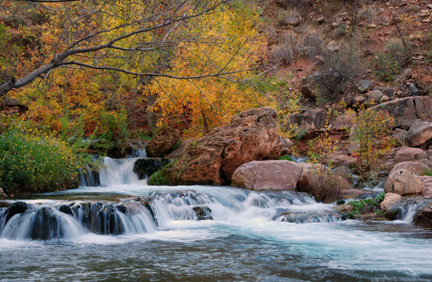When Northern Arizona University scientists helped restore Fossil Creek to its original flow, they expected native fish to return in abundance, but they didn’t expect a surge of visitors.
“We have this fear that we are going to love it to death,” says Jane Marks, an associate professor in NAU’s biological sciences, who worked with scientists, environmentalists and businesses to return the creek in Arizona’s rim country to its full and natural force.
The creek’s 15-year restoration efforts, featured in the 2006 award-winning public television documentary A River Reborn: The Restoration of Fossil Creek, included decommissioning a 100-year-old dam and hydroelectric facility. The film recounts how APS decommissioned its hydroelectric facility and collaborated with NAU and other groups to remove it and restore the water’s flow.
Creek restoration is going great, reports Marks. “Travertine dams are reforming and the native fish recovery is incredible.”
But as soon as the water began to flow again, so did people to enjoy it.
More than 100 undesignated campsites popped up along a 4.5-mile reach of the creek. Piles of trash grew and sediment was pushed back into the water. Managers fear that anglers’ bait could unknowingly reintroduce some non-native fish back into the creek, reversing one of the largest non-native fish removals in the Southwest.
Now Marks is part of an effort to protect the creek from partygoers and keep it pristine for visitors who respect its ecological significance. “It’s an Arizona wild place, and we hope to shift it from a party place to an ecologically important place,” she says.
In the fall of 2007, more than 40 representatives from 14 governmental, tribal and environmental groups formed the Fossil Creek Stakeholders Group to address the environmental impacts at the creek.
“It’s gotten fairly chaotic down there with informal campsites and off-road vehicles, so we are bringing in an education piece about offering no trace,” Marks adds. “Piles of litter are close to the river, so the idea is to make more formal campsites back off the river and re-vegetate the areas where people have been camping.”
Moreover, a Middle Fossil Creek Riparian Protection and Restoration Project grant from the Arizona Water Protection Fund for $250,000 will help protect the area.
Spearheaded by NAU research associate Michele James, working with Janie Agyagos, a wildlife biologist with the U.S. Forest Service, the grant will make a big splash in funding informational kiosks, clean-up efforts, the closure and rehabilitation of campsites near the river, designating campsites away from the river, as well as vegetation and water quality monitoring and education.
NAU will monitor water quality and vegetation and provide project coordination.
According to James, the grant was awarded to the U.S. Forest Service’s Coconino National Forest, contingent upon its finding $90,000 in matching funding. This funding has been obtained.
Fossil Creek serves as a national case study in dam decommissioning because a group of NAU scientists, as well as members of national and state agencies, began studying the ecosystem years before the dam was decommissioned.
“It is one of only a handful of dam decommissionings where we can research how the ecosystem is rebounding,” James says.
The creek also serves as an interdisciplinary classroom for NAU to teach biology, geology, forestry, recreational management and more.




